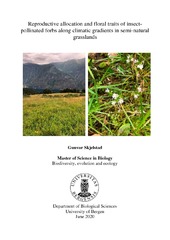| dc.description.abstract | Anthropogenic climate change is increasing both temperatures and precipitation in Western Norway, and these trends will be magnified in the future. This is expected to alter ecosystems, and to affect plants at different stages through their life cycle. Investigating variation in plants functional traits along spatial climatic gradients can be used to understand the effects of climate, and climate change, on different aspects of the plant life cycle. Many have used such space-for-time approaches to study vegetative traits, but reproductive- and floral traits have so far received less attention. Knowledge about these traits is important for understanding plant-pollinator interactions and how these interactions could be affected by future climate change. The aim of this study was to investigate how reproductive allocation and floral traits of insect-pollinated forbs in perennial grasslands vary with temperature and precipitation. I collected approximately 1300 individuals of 45 different species for measurements of plant vegetative and reproductive size, reproductive allocation and floral traits. To investigate intraspecific variation of reproductive allocation and floral traits, I also studied four species individually; Campanula rotundifolia, Potentilla erecta, Ranunculus acris and Veronica officinalis. The plants were collected in a climatic grid in western Norway consisting of 12 sites of semi-natural grasslands across three temperature levels and four precipitation levels. My results showed that across the community, forbs allocated more biomass to reproductive organs when temperatures were lower, while size and colour of floral displays were similar along the temperature gradient. Precipitation did not affect reproductive allocation or floral traits of the community. R. acris showed the same trend as the community for reproductive allocation, while there was no intraspecific variation along the temperature gradient for the other species. Size of floral displays of the four species changed little with temperature, as for the community. Increasing precipitation affected the number and size of floral displays of R. acris and P. erecta negatively, while C. rotundifolia and V. officinalis showed no effects of precipitation. The different trends found for the four species along both the temperature- and the precipitation gradient imply that these species have different reproductive strategies. These results also indicate that some species are more vulnerable to climate change than others. However, the effects of climate change on the forb communities and the individual species will be highly dependent on how pollinators and plant-pollinator interactions are affected by increasing temperature and precipitation. | en_US |
